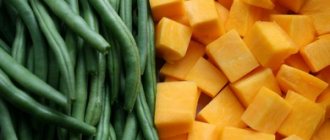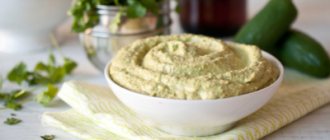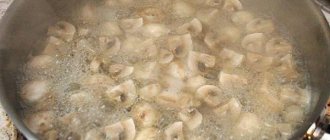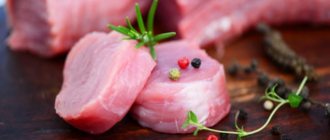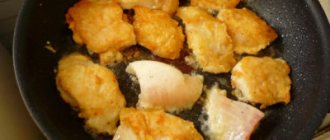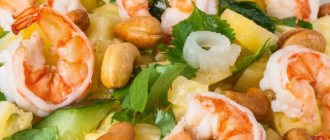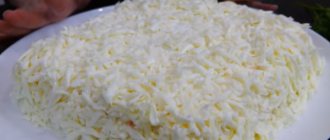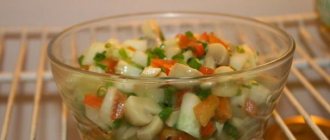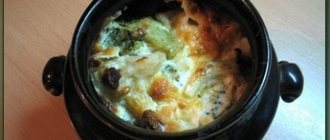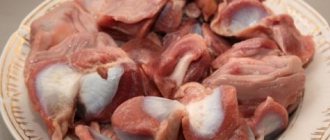What is foie gras and what does it look like?
The exquisite taste of foie gras makes its fans pay a lot of money to purchase the product in raw, semi-cooked or ready-made form. Both duck and goose foie gras are available on the market. Goose liver weighs up to 900 g and has a creamy taste and delicate aroma. Duck weighs about 600 g and has a bright “nutty” taste.
- Even having received a general answer to the question of foie gras - what is it, it is worth understanding its types. There are four of them: raw, fresh (with a minimum degree of heat treatment at 50 degrees), partially cooked and canned.
- The canned product does not lose its taste throughout the year.
- Raw foie gras spoils quickly. It can be stored in vacuum packaging for no more than a week.
Knowing what foie gras is eaten with will help you choose the right accompaniment for this delicious product. Classic accompaniments to dishes made from fresh or frozen foie gras are fried chanterelles, green salad, caramelized pears and wholemeal bread. Foie gras is served at the beginning of a meal, as an appetizer, with dry white wine or Calvados.
- The classic serving of foie gras is a piece of liver placed on warm, lightly toasted bread.
- Serving foie gras with jams and sour sauces is especially popular; with this combination, the liver acquires a pleasant sweetish taste.
Cooking foie gras is a delicate matter. it is necessary in a dry, hot frying pan, for several minutes on each side, trying to melt the fat out of the product as much as possible. Another option is cooking in the oven. It is prepared by baking, which has a similar name to a baking dish.
- Almost every recipe starts with thawing the liver.
- The next stage is cutting. Using a special spatula or the blunt side of a knife, the liver is carefully disassembled, removing the vessels.
- Another step is marinating the liver. It is marinated in alcohol, spices, and cream.
Sophisticated gourmets do not ask the question: classic foie gras - what is it? They know that this is a roll made from marinated pieces of goose liver, cooked in a gentle way - in foil, steamed. Due to this, the melted fat forms a bright yellow shell, the liver remains tender and acquires a creamy taste.
Ingredients:
- foie gras - 550 g;
- salt - 1/2 teaspoon;
- ground black pepper - 1/2 teaspoon;
- dry white wine - 60 ml.
Preparation
- Divide the liver into pieces.
- Dip in spice and wine marinade.
- Place on top of each other on a sheet of foil.
- Roll up and refrigerate overnight.
- Steam for 8 minutes on each side.
- Cool for 30 minutes at room temperature and 48 hours in the refrigerator.
- Serve foie gras the French way on slices of toasted bread.
It’s simple to prepare, you just need to fry the slices in a frying pan and simmer in the oven until they become springy. It’s more difficult with the side dish. It should complement the tender foie gras with sweetness, without overpowering it with its own taste. The ideal option is asparagus, which represents luxury in the world of vegetables.
Ingredients:
- asparagus stalks - 4 pcs.;
- foie gras - 300 g;
- butter - 80 g;
- onion - 1 pc.;
- blackberries - 120 g;
- balsamic vinegar - 20 ml;
- sugar - 40 g;
- water - 450 ml.
Preparation
- Fry the onion in oil.
- Add 100 g of berries, a pinch of sugar and balsamic.
- Simmer for 5 minutes. Puree.
- Boil asparagus in sweetened water.
- Brown the foie gras slices in a dry frying pan.
- Afterwards, bake for 5 minutes.
- Assemble the foie gras dish by placing the liver, asparagus, sauce and fresh blackberries on the dish.
Duck liver pate foie gras - recipe
Foie gras liver pate - made in the oven. Foie gras is laid out in layers in a special terrine form and baked on a baking sheet with water for about an hour. As a result, the fat melts slowly and the liver acquires a creamy pate-like consistency. Made from duck foie gras. It has a rich taste, so the dish turns out much more colorful.
Ingredients:
- duck liver - 450 g;
- salt - 10 g;
- nutmeg - 5 g;
- sugar and ground black pepper - 5 g each.
Preparation
- Soak the liver pieces in salt water for 4 hours.
- Season and place in a parchment-lined pan.
- Cover with foil, place in a tray with water and bake at 120 degrees for 50 minutes.
- Drain fat container. After 30 minutes, cover the terrine with it.
- Refrigerate 12 hours.
Experienced chefs say that if there is delicious foie gras on the plate, then there must be fruit next to it. Traditionally, caramelized apples. They add a refreshing flavor to the dish, contrasting the delicate texture with the crispy slices of liver. With sugar-butter caramel, foie gras turns out even more tender and sweeter.
Ingredients:
- foie gras - 350 g;
- apple - 1 pc.;
- butter - 60 g;
- sugar - 40 g;
- brandy - 40 ml.
Preparation
- Melt butter in a frying pan, add sugar.
- Wait for caramelization, add apples and simmer for 2 minutes.
- Pour in brandy and remove from heat.
- Slice the foie gras, season and fry for a minute on each side.
- Serve with apples and sauce.
Foie gras escalope is smooth and round layers of liver 1.5 cm thick, which are fried for a minute on each side, becoming golden brown on the outside and remaining slightly raw on the inside. Fast and not difficult. This cooking technique does not require time spent on a side dish, therefore, the liver is simply served with fruit sauces.
Ingredients:
- foie gras escalopes - 4 pcs. 70 g each;
- mango - 1 pc.;
- wine vinegar - 40 ml;
- spices to taste.
Preparation
- Cut the mango into 4 wedges. Cut one into slices, puree the rest and season with vinegar.
- Fry the escalopes for a minute on each side.
- Transfer to a plate. Garnish with sauce and mango slices.
It’s good that everyone can choose a recipe for cooking foie gras according to the contents of their wallet. Those who have the finances and want to experience all the charm of this product simply must try the foie gras terrine with truffle. Of course, with blacks. Unlike white ones, even without heat treatment they perfectly reveal the aroma and taste.
Ingredients:
- foie gras - 500 g;
- black truffle - 50 g;
- port wine - 300 ml;
- spices to taste - 5 g.
Preparation
- Marinate the foie gras in port wine and spices for 4 hours.
- Afterwards, bake at 150 degrees for 10 minutes.
- Place part of the liver in the terrine, top with slices of mushrooms, cover with the remaining liver and place under pressure for an hour.
- Drain juices and fat and refrigerate for another hour.
Cooking foie gras at home means experimenting with taste and presentation. A good solution is to combine the traditions of two cuisines by filling Italian ravioli with French foie gras. Nourishing, elegant and financially profitable, because the filling can be supplemented with champignons and cheese, reducing the consumption of an expensive product.
Do you want to experience French cuisine? Then figure out how to cook foie gras.
What is the name of goose liver pate? Foie gras: cooking recipe (8 photos)
This dish is a favorite among gourmets, but most people are rather conflicted about it. It is tender, melts in your mouth and leaves an unusual aftertaste. What are we talking about? Of course, about the specially prepared goose liver pate. This gastronomic masterpiece from French chefs is a traditional Christmas dish and a symbol of luxury. Every self-respecting person should try it at least once in his life. We'll tell you what goose liver pate is called, how to prepare it and serve it correctly in our article. Let's present several options for its preparation. Goose liver pate: what is it called and why?
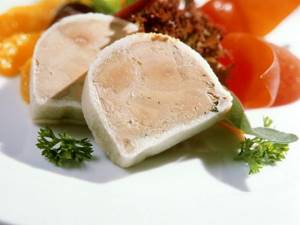
It is prepared from goose liver and is called pate, although the ingredients for it are almost never crushed until smooth. And there is one simple explanation for this. But first you need to say what goose liver pate is called. And only after that you can start preparing it. In French, the name of the pate is foie gras. In Russian the dish is called “foie gras”. Translated, this means “fatty liver.” For its preparation, the offal of a goose fed in a special way is actually used. To make the liver large and fatty, the bird is placed in a cage. Then the goose is force-fed, literally by the hour. This diet leads to an increase in offal in an amount 10 times greater than normal. So why is foie gras still a pate? The fact is that the fatty liver of a goose after heat treatment turns out to be so tender that it simply melts in the mouth and, accordingly, does not need additional grinding. Thus, the finished dish resembles a real pate in taste and consistency. It turns out so dense that it is cut into slices rather than spread on bread, as most people are used to. In addition to natural goose liver, other ingredients can be added to the pate. But their content should not exceed 50%. In France, this is enshrined at the legislative level. History of the dish
Although the recipe for foie gras belongs to French cuisine, the technology of force-feeding geese in order to obtain fattier and higher-quality liver was invented by the ancient Egyptians 4,000 years ago.
They raised their poultry on figs. Later, this same technology was adopted from them by Jews, who ate only goose fat, and sold the liver itself, which was considered non-kosher, at a profit. But the Romans, on the contrary, prepared only the offal of geese and ducks. Foie gras was one of the most popular dishes of the ancient world. The first recipes for foie gras date back to the 4th-5th centuries. But they do not contain a step-by-step description of the preparation process. But in French cookbooks, starting from the 17th century, all actions are described in stages. That is why France is considered the birthplace of foie gras. In French, foie gras is called foie gras. It is believed that the word foie, which translates as “liver,” comes from the Latin ficatum, which means “fig.” But the ancient Egyptians fed geese with figs. Today, France is considered the leader in the production of goose liver. Hungary, Belgium, Spain, the USA and Poland are not far behind the French. And in the Alsace region, a special breed of birds is raised, the liver of which weighs up to 1.2 kg. Foie gras with pear: ingredients
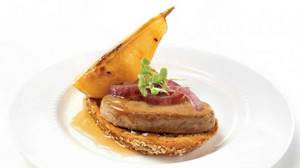
To prepare the most famous goose liver dish, you will need the following ingredients:
- goose liver - 500 g;
- pear - 1 pc.;
- cognac - 70 ml;
- butter - 20 g;
- salt - ½ tsp;
- black pepper - ½ tsp;
- sugar - ¼ tsp;
The liver can be used either as whole pieces or as a block, but always raw. Any pear will do. But please note that they must first be soaked in cognac, and only after that proceed to the liver. Step-by-step preparation of the dish
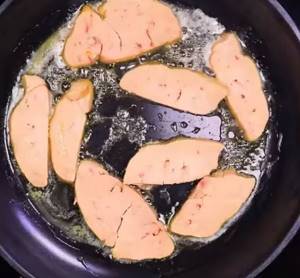
The foie gras recipe includes the following sequence of actions:
- Cut the liver lengthwise into plates 0.8-1 cm thick. The pieces should not be too thin, since a lot of fat will be released from them during the frying process.
- Salt the goose liver plates and add black pepper.
- Place the pieces in a dry frying pan preheated over medium heat. No need to add vegetable oil or butter. The fat contained in the liver will be enough.
- Fry the pieces on each side for exactly 1 minute. Transfer foie gras to a clean plate. Drain the fat from the pan. It can also be used to prepare other dishes.
Now you can start working on the fruit to serve the dish. Pears in cognac
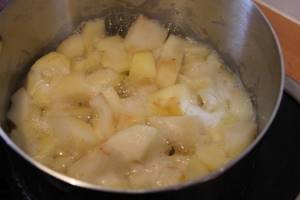
This stage of cooking foie gras can be broken down into steps:
- Peel the pears and cut into 4-6 pieces. Pepper them a little, add sugar and cognac. Stir the pears in alcohol and leave for 40-60 minutes at room temperature to marinate.
- In a thick-bottomed saucepan or frying pan, melt a piece of butter and fry the fruit in it, after draining the juice. The fire must be high so that the pears cook quickly and do not fall apart.
- After a couple of minutes, pour the alcohol in which they were soaked onto the almost ready fruits. At the same stage, it is recommended to flambé the pears. To do this, you need to lower a burning match into cognac. A fire will immediately break out. If there is little alcohol, it will go out on its own. If this happens after 30 seconds, cover the saucepan with a lid.
Serve foie gras immediately with cognac pear. To do this, you can place the liver on a slice of whole grain bread and pour over the remaining juice. Goose liver terrine
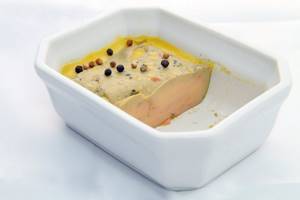
The following dish is an excellent appetizer option for a holiday table. This is a real delicacy, with a soft, refined taste and pleasant aroma. Terrine, or baked pate, is both soft and dense in texture. It can be served as a snack on crackers or toast. Preparing terrine is not difficult at all:
- Goose liver (1 kg) cut lengthwise into three layers.
- In one container, combine 150 ml of port wine and 50 ml of cognac.
- Place all 3 layers of liver in a 25 cm long baking dish. Sprinkle each layer with salt, pepper and nutmeg and pour over the alcohol mixture.
- Cover the pan with cling film and refrigerate for 5 hours.
- Preheat the oven to 150 degrees.
- Prepare a deep baking tray. Place the terrine pan in it, covering it with foil or covering it with a lid. Pour enough hot water into the pan so that it reaches the middle of the pan.
- Cook the terrine for 20 minutes. Then remove the pan from the oven, remove the lid, and place a weight of 0.2 kg on top of the liver.
- Cool the dish first at room temperature and then in the refrigerator for 12 hours.
The simplest goose liver pate
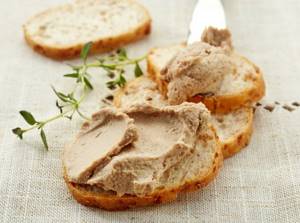
As a rule, foie gras is not ground until smooth. There is simply no need for this, since the liver, containing so much fat inside, is already so soft that it literally melts both in the pan and in the mouth. But if you wish, you can also prepare the more familiar goose liver pate. The following step-by-step instructions will tell you how to do it:
- Melt pork fat (100 g) in a frying pan and fry 3 onions and 2 carrots, chopped as desired.
- After 5 minutes, add goose liver (0.5 kg) to the vegetables, cutting the offal into small pieces. Cook for 10 minutes. At the very end add 2 tsp. salt, 1 tsp. black pepper and ½ tsp. nutmeg.
- Transfer the liver with vegetables (without fat) into a convenient bowl and grind with an immersion blender until smooth.
- Return the pate to the pan, pour 200 ml of milk into it. Simmer the dish covered for another 5 minutes, then cool and serve.
Duck liver pate
Almost 90% of foie gras is not made from goose liver. And all because raising ducks is more economically feasible than raising geese. This dish turns out to be more budget-friendly, and almost anyone can prepare it. And you need to do it like this:
- Cut the duck liver into 1.5 cm pieces each.
- In a frying pan with a little olive oil, fry shallots (4 pieces) until golden brown.
- Add liver pieces to the onion. Fry them on one and the other side for 1 minute. Season with salt, pepper, and Provençal herbs to taste.
- Grind the ingredients with a blender to a fine consistency, adding 30 ml of cognac if desired. Give the finished pate a beautiful shape, then cool it in the refrigerator for 2 hours.
How to serve foie gras
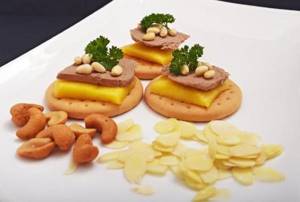
This goose liver dish is served either with a side dish or simply with bread or crackers in the form of a sandwich. So that the dense pate can be easily cut into portioned pieces, it must be cooled well, and removed from the refrigerator 15 minutes before starting to prepare the snack. When serving, foie gras is cut into thin slices no more than 1 cm thick. The tender liver harmonizes well with sweet sauces and red wine.
Material taken: Here
What it is?
Foie gras is the fatty liver of fattened geese or ducks. By the way, the name is translated from French as “fatty liver,” so it fully reflects the essence of the product.
Birds are fattened in a special way, and this process cannot be called humane. At first, geese and ducks feed naturally, then they are locked in cramped cages (thus limiting movement and energy expenditure) and fed food rich in starch and protein. And the last stage is forced feeding. A special “gavage” pipe is placed directly into the bird’s throat, through which grain and fat are fed daily, and the volume exceeds the norm by 10 times!
The result is an exquisite delicacy that is popular not only in France, but throughout the world. One liver weighs about 500-700 grams, and the volume of fat in it reaches 40%. The shade can vary from pale yellow to light pink, and the structure is dense, but at the same time very delicate.
What is foie gras
Foie gras literally means “fatty liver”. As a rule, goose liver is used for cooking. But today duck liver is used for this purpose. Moreover, recently duck liver is more often used, since it is much easier to produce.
Since ducks are widespread, today foie gras made from the liver of this bird is more popular than goose. In addition, its cost is much lower. But geese are not an industrial product, and foie gras made from them is quite expensive, because it requires significant effort to produce.
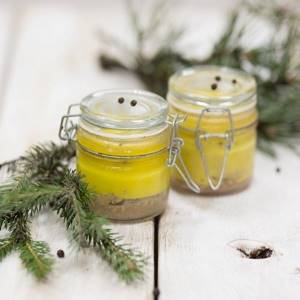
Goose liver has a delicate creamy taste with a slight bitter aftertaste. At the same time, duck liver is characterized by a more pronounced and sharp taste and strong aroma. Therefore, when choosing products you will have to be guided by your own preferences.
How to cook?
How to cook foie gras correctly? There are many ways, and several will be discussed below.
Method No. 1
You can cook fried foie gras. For this you will need:
- 200 grams of foie gras;
- 2-3 tablespoons of vegetable oil (it is best to use olive oil);
- 3-4 lettuce leaves;
- a pinch of Provençal herbs;
- salt to taste.
Preparation:
- First, the liver must be washed well and cleared of all veins. Next, salt it a little and rub with Provençal herbs. But don’t overdo it with seasonings; they can overwhelm the taste of the most important ingredient.
- Cut the foie gras into small slices about 1.5 centimeters thick.
- Heat vegetable oil in a frying pan and fry the liver in it. How long to fry such a product? Since it has a delicate texture, literally a couple of minutes on each side will be enough.
- Serve the fried foie gras on lettuce leaves.
Method No. 2
You can make the most delicate pate from the fatty liver of a duck or goose.
List of required ingredients:
- 600 grams of fatty duck or goose liver;
- 70-80 grams of goose or duck fat;
- 1 onion;
- any seasonings to taste, for example, basil or Provençal herbs;
- salt to taste.
Step-by-step instruction:
- Wash the liver, remove the veins and cut into slices.
- Peel the onion and finely chop it.
- Melt the fat in a frying pan and first fry the onion until soft, and then the liver. If desired, you can simmer the ingredients under the lid for a couple of minutes to make them more tender. At the end or a minute before they are fully cooked, salt and season them.
- Now place all the ingredients in a blender or meat grinder and grind until you get a homogeneous mass.
- This delicate pate is best served with hot crispy toast, it’s very tasty!
Method No. 3
Prepare delicious savory foie gras with wine sauce. To do this you will need:
- 400 grams of duck or goose liver;
- ground black pepper;
- coarse salt (you can use sea salt);
- 70 ml of wine (it is better to use white, it is lighter and has a mild taste);
- 30-40 ml wine vinegar;
- a pinch of Provençal herbs or other seasoning of your choice.
Description of the cooking process:
- First, properly prepare the liver: wash it, devein it and cut it into medium-sized slices.
- Prepare the sauce. To do this, simply mix wine, seasonings, wine vinegar and ground black pepper.
- Lightly heat the salt in a frying pan, then add the liver and fry until done.
- Pour the sauce over the foie gras and simmer for literally two minutes, and then serve.
Method No. 4
This recipe is quite unusual, as it involves the use of berries. But the taste of the dish is simply amazing!
List of required ingredients:
- 500 grams of foie gras;
- 300-400 grams of berries (for example, viburnum, strawberries, rowan and so on);
- 3-4 tablespoons of sugar;
- 4 tablespoons of water;
- 3 leaves of fresh mint;
- salt;
- seasonings to taste.
Preparation:
- The liver needs to be washed and cleaned of veins, and then cooked in any way convenient for you, for example, fry in a frying pan or place in an oven preheated to 180 degrees for 20 minutes, after wrapping it in foil (this way the product will retain its juiciness). Before cooking, salt and season the foie gras, but not too much.
- Now proceed to preparing the berries. They need to be washed well and placed in a frying pan, sprinkled with sugar. When they release juice, add water and cook until thickened.
- Place the foie gras on a plate, cut into portions, and pour over the berry sauce. Garnish the dish with mint leaves.
Method No. 5
Prepare delicious and unusual marinated foie gras. Here's what you'll need for this:
- 600 grams of duck fatty liver;
- 500 ml wine;
- basil, herbs de Provence and nutmeg to taste (a little of everything);
- salt.
Instructions:
- Wash the liver and clean it of veins, season it and salt it, place it in any container and fill it with wine. In principle, you can choose any other alcoholic drink, depending on your preferences.
- Leave the foie gras to marinate for a day.
- Next, wrap the liver in foil and place in an oven preheated to 180 degrees. But place a container of water under the baking dish to make the heat treatment softer.
Method number 6
Foie gras with grapes will taste delicious and unusual.
Required ingredients:
- 300 grams of fatty goose liver;
- 100 grams of grapes (it is advisable to use the seedless variety);
- 1 tablespoon olive oil;
- salt to taste.
Process description:
- Wash the liver in running water and remove the veins. Wash and dry the grapes too.
- Heat the oil in a frying pan and fry the liver along with the grapes.
- This dish can be served with any sauce, for example, sweet and sour.
Treat yourself, your guests and loved ones with delicious dishes!
There are hundreds of delicacies in the world, many of which are associated with unrivaled French cuisine. For example: croissants, frog legs, foie gras. In the article you will learn what foie gras is, who created this dish and how to cook it correctly at home.
Foie gra means “fat liver” translated from French. Foie gras is a pink dish with a creamy flavor, prepared from the liver of fattened poultry - goose or duck.
Origin story
France is considered the birthplace of this aristocratic treat, but foie gras first appeared in ancient Egypt. Observant residents of the land of the pharaohs noticed that the liver of wild ducks that have gained weight before a long flight, or of fattened geese, is characterized by a delicate taste.
After some time, the food began traveling around the world and reached France. Thanks to the efforts of French chefs, the classic recipe has been significantly improved. In the 18th century, the French marquis, while preparing to receive high-ranking guests, ordered the cooks to prepare an unusual dish that would surprise the invited elite.
After much deliberation, the chefs tested the ancient Egyptian recipe by combining ground poultry liver with lard, and applying the resulting mixture as a filling to the tender dough. The guests really liked the dish and gained incredible fame. As a result, foie gras became the pride of French cuisine and its industrial production was established in the country.
Foie gras recipes. 10 ways to cook foie gras
The word “foie gras” is familiar to many of us, and along with frog legs, croissants, ratatouille and other things, it is clearly associated with French cuisine. But in reality, few people have tried this delicious dish, not to mention knowing the recipes for its preparation.
This is partly due to its relatively high cost, because the dish has long been considered a symbol of gastronomic luxury. But sometimes you want to feel like a true aristocrat and find out what these French gourmets admire so much, and also cook foie gras according to their recipes at home!
Content
So what is foie gras? Translated from French, foiegras means “fat liver.” In the traditional presentation, this is goose liver prepared in a special way. However, in the modern world, chefs have adapted to preparing foie gras from the livers of ducks, chickens and other birds. Duck liver has now even replaced goose liver due to easier production, and 90 percent of foie gras supplied to markets is made from it. Opinions about which one is tastier differ very, very much - this is largely a matter of taste. Goose liver foie gras has a delicate and creamy taste, while duck liver foie gras has a more distinct and sharp taste.
A Brief History of Foie Gras
In fact, it would not be entirely fair to say that we owe the appearance of foie gras to the French. The true right of discovery here belongs to the ancient Egyptians. It's hard to believe, but in reality the dish was invented about five thousand years ago! It was then that smart Egyptians, having compared the taste of the liver of their domestic geese and wild geese, eating before their flight, appreciated the benefits of the latter. As an experiment, they tried to force-feed domestic geese with figs until the same effect was achieved. Later, the recipe for making foie gras migrated to the Jews, and then to the Romans, where it gained enormous popularity. The authorship is attributed to the French because it was they who had the first documentary recipes for preparing the dish.
What's the weather like and what to do in Paris in June, festivals, fairs and sporting events.
How to rent an apartment in Paris, all the information is here.
Applying for medical insurance for a Schengen visa using the link https://tourtofrance.net/sovety-turistam/oformlenie-meditsinskoj-strahovki-dlya-shengenskoj-vizy.html
Birds raised on farms for the production of foie gras, starting from 8-10 weeks, begin to be force-fed. This feeding is called gavage (gavage in French means force feeding). Together with restricting the ability to move, this can enlarge the liver by 10 times. The “diet” of the fattened bird must also be special; the taste and color of the finished liver will depend on this. Boiled corn, figs, flour, and walnuts are used as food.
France is famous for the production of foie gras all over the world; there, especially in the southwest, a real cult of this delicacy has formed. In different regions of the country, special recipes for its preparation have developed, differing from each other. Some of them have not changed since they first appeared in cookbooks of the 17th century. Foie gras in France is a symbol of sophistication, unsurpassed taste, and one of the indispensable attributes of the festive Christmas table. In addition to France, although significantly inferior to it in enthusiasm, other countries are also involved in the production of foie gras - for example, Spain, Hungary, Poland.
It is worth noting that foie gras is not only a delicious dish, but also healthy. Goose liver contains iron and other substances that are easily absorbed by the body. It reduces cholesterol levels in the blood, improves brain function, and promotes better blood circulation. We offer you a selection of 10 goose liver foie gras recipes.
1 cooking method. Fried foie gras recipe
Ingredients:
- Goose liver – 100-200 g;
- Lettuce leaves – 2-3 pcs;
- Seasonings to taste.
Description of preparation:
Before frying, thoroughly process the liver, removing all veins. Cut into slices, add seasonings and fry in goose fat (if not, in vegetable oil). Foie gras cooks quickly, so one minute on each side will be enough. Do not overdo it with seasonings, as this will overwhelm the taste of the dish itself. Many gourmets prefer to add just a little salt and pepper.
Serve with lettuce or other greens.
There is also an alternative version of this classic recipe, according to which the liver is first marinated in cream.
2nd method of preparation. Foie gras pate recipe
Ingredients:
- Goose liver – 600 g;
- Goose heat – 90 g;
- Onion – 1 piece;
- Seasonings to taste.
Description of preparation:
Finely chop the onion and fry over goose heat. Add liver and fry for two minutes. At the end of frying, season (you can use, for example, Provençal herbs). After this, place everything together in a blender and finely chop. Serve the finished pate with hot toast.
3 way of preparation. Pickled foie gras recipe
Ingredients:
- Frozen goose liver – 400-600 g;
- Wine or cognac – 300-500 ml;
- Truffles - to taste
- Nutmeg - to taste
- Seasonings - to taste
Description of preparation:
Thaw the liver in warm water. Season to taste and place in a small saucepan so that the liver fits tightly against it. Pour in the alcoholic drink of your choice (it can be almost anything, it all depends on your taste). Add truffles and nutmeg for added spice and marinate for 24 hours. After the expiration date, bake in a water bath in the oven. Leave the pan without a lid and cover with foil. Serve with hot toast.
4 cooking method. Recipe for foie gras with grapes
Ingredients:
- Goose liver – 300 g;
- Grapes – 100 g;
- Sauce.
Description of preparation:
Peel the liver from the veins, cut into large pieces, put in a frying pan along with the grapes and fry in oil or goose fat for a minute. Serve with a sauce of your choice, such as vanilla.
5 cooking method. Stuffed foie gras recipe
Ingredients:
- Goose liver – 600 g;
- Minced beef – 300 g;
- Truffle – 1-2 pcs;
- Goose fat.
Description of preparation:
Clean the liver, stuff it with minced beef, add truffle. Fry in goose fat, cool, cut. Serve with soft white bread.
6 cooking method. Country-style foie gras recipe
Ingredients:
- Goose liver – 300-400 g;
- Coarse salt
- Black pepper
- Wine
- Vinegar
Description of preparation:
Lightly sprinkle the pan with salt and black pepper and heat it up. Add the liver, lightly pouring it with wine and vinegar. Fry until done.
7 cooking method. Tender foie gras recipe
Ingredients:
Description of preparation:
Cut the liver into small slices (1 cm). Fry in a frying pan without the help of oil or fat, or with a minimum amount of them. The resulting foie gras will be well-cooked on the outside but very tender on the inside. Serve with fruit or bacon.
8 cooking method. Foie gras recipe without heat treatment
Ingredients:
- Goose liver – 500 g;
- Salt and pepper to taste.
Description of preparation:
Rinse the liver, clean it, place it on a clean, dry towel. Sprinkle with salt and pepper, wrap in a towel and place in the refrigerator for a day. When the time is up, remove the liver, clean off the remaining salt, cut into slices and serve with jam to your taste.
9 cooking method. Foie gras recipe with berry sauce
Ingredients:
- Goose liver – 500 g;
- Wild berries – 400 g;
- Sugar – 4 spoons;
- Mint leaves – 2-3 pcs;
- Seasonings to taste;
- Water - 4 tablespoons.
Description of preparation:
Prepare the liver in any way - fry or bake in the oven. Place the berries in a preheated frying pan and sprinkle them with sugar. Add four tablespoons of water and fry over low heat until the berries thicken. Chop the liver and fry in a separate pan with seasonings. Place the finished foie gras on a plate, pour over the berry sauce and garnish with mint leaves.
10 cooking method. Foie gras recipe with mushrooms
Ingredients:
- Goose liver – 600-700 g;
- Milk – 400 ml;
- Porcini mushrooms – 200 g;
- Minced pork – 500 g;
- Lard – 50 g;
- Cognac – 100 ml
- Nutmeg
- Bay leaf
- Salt and pepper to taste
Description of preparation:
Wash, clean and marinate the liver in milk for 2 hours. Wash the mushrooms and finely chop them. Stuff the liver with mushrooms, place in a small container, pour in cognac and leave for another two hours. Place the liver on a baking sheet, cover it with minced meat, and decorate with thin pieces of lard. Moisten the top with the remaining cognac. Bake in a water bath for one and a half hours. Cool the finished dish and put it in the refrigerator for a day.
In our country, cooking foie gras is not the easiest thing, if only because the liver of a well-fed bird is not easy to find. And the cooking recipes are not among the simplest; there are many nuances. But there are also advantages, for example, short cooking time, or versatility in terms of side dishes. Almost everything goes well with foie gras - fruits, sauces, meat, rice, mushrooms. If you dare to try and do it right, you can be sure that the result will not disappoint you.
tourtofrance.net
How is foie gras made?
Foie gras regularly sparks controversy. Animal rights activists argue that liver pate is a barbaric dish because geese and ducks are tortured and killed for its sake. Connoisseurs and gourmets are ready to do anything for the excellent taste and subtle aroma of sophistication.
Pate made from goose liver is a national French dish. France ranks first in the supply of foie gras to the world market. Recently, production of the delicacy has opened in the USA, China, Bulgaria and Hungary. In a number of European countries, the production and sale of liver pate is prohibited by law. These include Germany, Poland, Türkiye, and the Czech Republic.
According to culinary specialists, the taste, aroma and other consumer characteristics of the pate are due to special production technology. Goose liver is the main ingredient in the classic 18th-century foie gras recipe. In the 21st century, in most cases, the liver of ducks of the “Mulard” and “Barbary” species is used. The goose is a high-maintenance bird, which makes the final product more expensive.
- To obtain the delicacy, the birds are fed in a special way. In the first month, the birds' diet is normal. When they grow up, they are moved to small and completely isolated cages that limit their ability to move. At the same time, the diet of geese and ducks is changing, the basis of which is food rich in starch and protein.
- A sedentary lifestyle and special nutrition lead to a rapid increase in the weight of birds. From the eleventh week, ducks and geese are force-fed. Each bird eats about 1800 grams of grain every day. As a result, in two weeks the liver increases many times over and reaches a weight of up to 600 grams.
Experts say:
- Foie gras has an excellent taste.
- Rich vitamin and mineral composition.
- Regular use prolongs life.
The main benefit of liver pate is represented by a large amount of beneficial acids. There is some truth in these words, as evidenced by the many centenarians living in southwestern France.
How to cook foie gras at home
For most people, foie gras is a delicacy, an object of admiration and adoration. Many people have heard about this delicacy, but I am sure that only a few have tasted it. Therefore, I will consider a classic recipe for making foie gras at home.
Essentially, foie gras is a pate made from the fatty liver of a duck. Purchasing the main ingredient is extremely problematic, and the cost is steep. Answering the question of how much foie gras costs, I will say that you will have to pay 550-5500 rubles for this delicacy in the store. You can cheat a little and buy regular liver or pate. The recipe uses original foie gras and 2 sauces.
Ingredients:
- Fatty goose liver - 500 g.
- Port wine - 50 ml.
- Salt, white pepper.
FRUIT SAUCE:
- Apple juice with pulp - 50 ml.
- Soy sauce - 1 spoon.
- Honey - 1 spoon.
- Salt pepper.
BERRY SAUCE:
- Blackcurrant - 1 cup.
- Honey - 1 spoon.
- Sherry - 100 ml.
- Salt, white pepper, refined oil.
Preparation:
- I'm preparing the liver. I carefully remove the bile ducts, nerves and films. Then, I wash it thoroughly, put it in a bowl, salt it, sprinkle it with pepper, and fill it with port wine. I put it in the refrigerator for an hour.
- While the oven is heating up to 180 degrees, I grease a small mold or frying pan with vegetable oil. I also use it to lubricate the food foil in which I wrap the liver.
- After wrapping it in foil, I move the liver into a baking container, make several holes with a toothpick and put it in the oven.
- I bake the foie gras for about half an hour, periodically draining the released fat. I take the finished product out of the oven. According to the classic recipe, after cooling, the baked liver, along with foil, is placed in the refrigerator for two days. I do not do that.
- I take the finished liver out of the foil, cut it into pieces and serve with your favorite side dish or sauce.
I warn you, the delicacy is very “heavy” for the stomach. Combine it with a light vegetable side dish, mushrooms or sauce.
Preparing fruit sauce
To prepare the fruit sauce, pour apple juice into a saucepan, add honey and soy sauce. I put the dishes on the stove, turn on low heat and cook, stirring, until the sauce thickens.
Preparing berry sauce
To prepare the berry sauce, place fresh blackcurrants in a frying pan with hot goose fat and fry for about a minute. Then I add honey, pour in wine and stir. Keep the frying pan over moderate heat until the sauce reaches a thick consistency.
Video recipe
Foie gras is prepared in several ways. Cooks of different nationalities are constantly trying to create a unique recipe. However, the crown of excellence belongs to the French geniuses of cuisine. It is not surprising, because for France, foie gras is a symbol and national treasure.
The French bake foie gras, fry it in pieces, boil it, prepare tender pates, preserve it and eat it raw. The important thing is that in any form the delicacy looks appetizing and has excellent taste.
The recipe for this dish was previously considered very rare, but with the development of the Internet it can be found without problems. As the name suggests, foie gras is a French dish. Foie gras is very healthy, but, in turn, it is also high in calories (500 Kcal/100 grams). Today we will tell you how to prepare this delicious dish.
The main ingredient of the dish is, first of all, goose liver - a fairly fatty food - the goose needs to be fattened in a special way, for example, walnuts, figs and flour, in order to maximize the fat content of the goose liver.
Foie gras what is it? 4 recipes at home
Foie gras is a fairly famous delicacy that can be seen on the tables of the social elite and celebrities. The dish has a refined aftertaste, delicate texture and delicate aroma. Many housewives ask questions about what foie gras is and how to cook it correctly.
What is foie gras - what is it made from and what does it look like?
Foie gras is translated from French as fatty liver. This is a popular delicacy in France. Foie gras is prepared in a special way from the liver of a goose or duck. The bird is fattened in a special forceful way, including a large amount of protein, fats, and vitamins in its diet. Geese are fed and limited in movement, receiving liver with 45% fat content.
In cooking, foie gras is divided into 3 types:
- Raw. Used as a base for most culinary dishes. Raw liver is light yellow in color, covered with a shiny glossy shell.
- Half-finished. This is pasteurized foie gras that is cooked at 100 degrees. The consistency thickens, porosity and excess liquid disappear. The color changes to light brown with dark veins.
- Canned. It is prepared for a long time under the influence of high temperatures. The tender liver turns brown, with no streaks of blood or fat.
Foie gras is consumed in many European and Asian countries. Traditionally, the dish is served cold before salads and appetizers. Supplement with dry white wine.
Classic goose liver recipe
Goose liver foie gras is a delicious dish with a mild taste. The dish will take center stage on your holiday table. Even the most fastidious gourmets will appreciate this culinary masterpiece.
Ingredients:
- goose liver – 130 g;
- fresh cream – 80 g;
- rice – 45 g;
- pineapple – 25 g;
- walnuts – 45 g;
- olive oil – 35 g;
- salt and spices to taste.
Preparation:
- Rinse the liver under running warm water and wipe with paper towels. Place in a bowl and pour in cream. Place the container in a dark place for 3-4 hours.
- Divide the liver into 2 equal parts. Beat lightly. Rub the liver on all sides with salt and spices.
- Heat the frying pan over high heat. Place the liver on it and fry for 1.5 - 2.5 minutes. It is not advisable to use oil.
- Rinse the rice, place in a saucepan and cover with cold water. Cook for 11 – 14 minutes. Drain the liquid and cool.
- Peel the walnuts and grind in a blender to a powdery mass.
- Remove the skin from the pineapple and cut into small thin cubes.
- Place the cooled rice in a greased frying pan. Add nuts and pineapple. Fry, stirring gently, for 8-13 minutes.
- Place the liver in the center of a wide dish and arrange the rice nicely around the edges.
The dish can be decorated with lemon slices or lingonberries. The dish is served with fruit sauces and berry fruit drinks.
Homemade chicken liver foie gras
Not everyone can go to France and taste the delicacy in the best traditional restaurant. But every housewife can cook foie gras at home and surprise her family. The most delicate pate can be added to the menu of children and the elderly.
Ingredients:
- chicken breast – 260 g;
- chicken liver – 460 g;
- carrots – 1 piece;
- onion – 1 piece;
- butter cow butter – 65 g;
- cheese – 85 g;
- eggs – 3 pieces;
- fresh cream – 130 g;
- sour cream 4 tablespoons;
- salt – 1 teaspoon;
- sugar – 1 teaspoon:
- pepper to taste.
Preparation:
- Rinse the chicken breast under running warm water and cut into large pieces.
- Soak the liver in cold water for 33-36 minutes, chop into thin slices.
- Rinse the carrots under cold water, peel, and chop into thick rings.
- Peel the onion and cut into squares or slices.
- Place the breast, liver, onion and carrots in a deep saucepan, add oil and spices. Simmer for 42 - 44 minutes. Stir gently every 4 – 6 minutes.
- Cool the meat and vegetables, beat them with a blender.
- Mix cream and sour cream with eggs. Pour the mixture over the meat and vegetables. Add grated cheese. Beat with a blender.
- Cover a baking sheet with craft paper and pour the pate onto it. Place in the oven, which is preheated to a temperature of 170 - 190 degrees, for 36 - 38 minutes.
- Remove the finished dish from the oven and place in a cool, dark place until completely cooled.
Foie gras is served with mushroom or apple sauce. The pate can be decorated with basil or cilantro leaves.
Prepare foie gras from duck liver
Foie gras symbolizes luxury and sophistication. The duck liver dish will surprise guests with its uniform consistency and delicate structure. When cooking, it is recommended to use wild duck liver; it gives the dish an additional piquant aroma.
Ingredients:
- duck liver – 280 g;
- green grapes – 120 g;
- olive oil – 45 g;
- salt and spices to taste.
Preparation:
- Rinse the duck liver under running warm water and cut into large pieces. Remove all veins and seals.
- Place the liver pieces on a greased frying pan, add 0.5 cups of water, spices and simmer under a closed lid for 8 - 13 minutes.
- Wash the grapes in warm water, remove the seeds, cut each berry into 4 parts.
- Pour out excess liquid from the frying pan, add oil and pour grapes onto the liver. Fry for 1-2 minutes.
Serve with tomato sauce and sparkling wine. You can experiment and complement the serving with vanilla or caramel jelly.
Fried foie gras recipe
This is one of the variations of the dish, which is high in calories. The incomparable taste of liver goes perfectly with mulled wine or cider.
Ingredients:
- goose liver – 460 g;
- lettuce – 120 g;
- vegetable oil – 25 g;
- salt and spices to taste.
Preparation:
- Soak the liver in warm water for 24 – 27 minutes. Rinse and remove excess liquid with paper towels. Cut the liver into large pieces, rubbing each with salt and pepper.
- Add some oil to a hot frying pan. Place the liver pieces and fry on all sides for 1 – 3 minutes.
- Preheat the oven to 185 degrees.
- Sprinkle oil into a baking dish and pour out the liver. Place the pan in the oven for 25 - 31 minutes.
- Rinse the lettuce leaves in clean water and dry.
- Place lettuce leaves on a wide glass dish. Place the finished liver on top. You can decorate foie gras with rowan berries and apple slices.
The dish can be complemented with sour cream and cheese sauce and onion rings.
What sauces are suitable for foie gras?
Traditionally, foie gras is served with sauce. There are many variations of sauces. Fans of spicy, spicy cuisine complement the dish with garlic and tomato sauces. Connoisseurs of the classics prefer cheese and sour cream sauces. Experimenters and daring people eat foie gras with caramel and vanilla sauces. Vegetable, fruit and berry sauces are ideal for liver.
Berry sauce
The tart taste of black currant goes perfectly with the tenderness of the liver.
Ingredients:
- black currant – 55 g;
- red currant – 55 g;
- cream – 1 teaspoon.
Preparation:
- Rinse the berries thoroughly under running cool water and remove the stems. Grind in a blender to a paste.
- Pour cream into the berry mixture and mix thoroughly.
- If the sauce is too liquid, add a pinch of starch to it.
The sauce is served in a separate rosette, which is placed on the edge of the plate.
Cheese sauce
The sauce goes perfectly with meat and fish dishes.
Ingredients:
- hard cheese – 90 g;
- fresh cream - 90 g;
- cow's milk – 23 g;
- mustard – 1 tablespoon;
- salt and spices to taste.
Preparation:
- Grate the cheese.
- Pour the cream and milk into a saucepan and bring to a boil.
- Add cheese, mustard and spices to boiling cream. Stir and simmer for 3 – 6 minutes.
- Cool the sauce and pour on top of the liver.
You can supplement the sauce with 1 leaf of mint or oregano.
Tomato-garlic sauce
Hot sauce will appeal to lovers of Oriental and Asian cuisine.
Ingredients:
- tomatoes – 2 pieces;
- garlic – 5 cloves;
- salt and spices to taste.
Preparation:
- Place the tomatoes in boiling water for 12-14 seconds. After this, immediately plunge them into ice water. Make side cuts on the fruit, remove the peel and seeds.
- Free the garlic from the husk.
- Place tomato pulp, garlic and spices in a blender. Stir until you obtain a paste-like mass.
The sauce goes well with foie gras and other liver dishes.
Foie gras is an exquisite dish that is served in the best restaurants in the world. You can prepare it at home, you just need to strictly follow the recipe. The food will surprise and delight guests, decorating the festive celebration.m
attuale.ru
Foie gras recipe
Foie gras can be easily prepared at home and you don’t have to go to a restaurant. First of all, the liver must be cut into the number of pieces that you need. Heat a frying pan and sprinkle it with salt. The goose liver must be peppered, salted and seasoned with spices, then put the pieces in a frying pan.
The advantage of cooking foie gras is that the dish cooks very quickly, 10-15 minutes will be enough. Fry on one side for 5 minutes, turn over, place foie gras on a plate after 10 minutes.
Cooking goose foie gras, recipe No. 2: cut the liver after frying, preferably with a hot knife. Many chefs claim that the liver should be fried in goose fat. Can also be served in milk and honey. They even practice roasting in wine.
Historical Product Information
Foie gras is an exquisite delicacy on the holiday table . The taste of this dish has captivated many royals. Pate is considered to be a French delicacy. Why not? The origin of the name and the leading country of origin - almost all the details confirm this. But historical facts are stubborn things.
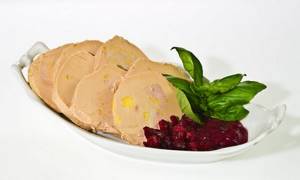
This dish was first seen on the tables of the inhabitants of Ancient Egypt. This is evidenced by ancient drawings discovered in ancient necropolises. Goose liver and its various recipes for preparing it at home were also described in ancient manuscripts.
The beloved delicacy of duck and goose liver soon became a cult favorite and was loved by the whole world. The fatty pulp was so to the taste that people began to force-feed and raise waterfowl and geese in a special way. The secret ingredient fed to birds to give their livers a unique flavor is figs. They supplemented the main diet.
There is constant controversy surrounding foie gras. Many people argue that it is cruel to raise birds this way, but the manufacturers of the product continue to do it.
Making foie gras sauce
Sauce takes its rightful place in cooking foie gras. It is prepared from various ingredients and in different ways. Most often they prefer alcohol, for example, wine, brandy, skate or whiskey with the addition of citrus fruits and grapes.
The fruits are cut, placed in a hot frying pan and poured with alcohol, sometimes orange juice is added. There are also “softer” sauces: made from milk and chocolate.
Foie gras is placed on a plate, poured over with sauce, sprinkled with herbs, nuts, and decorated with salad. Most often this dish is eaten with soft white bread or toasted croutons. Bon appetit!
Video recipes
Chicken liver foie gras:
Foie gras with strawberries:
Foie gras carpaccio:
Foie gras pate:
The famous delicacy foie gras, along with frog legs and croissants, is associated with France all over the world. The dish is light pink in color and has a delicate creamy flavor, obtained from the liver of duck or goose. Poultry raised on special farms is force-fed, due to which its liver increases in size by 8-10 times. So - foie gras, what is it? We will look at the history of the popular dish, the intricacies of preparation and the beneficial qualities of the product in our article.
Fried foie gras
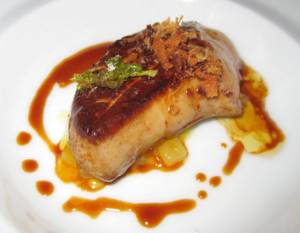
This delicacy recipe is the most common. Fried liver is easy and quick to prepare, and its flavor is as delicate as traditional foie gras.
Required Products:
- 500 g of goose or duck liver (you can prepare fried foie gras from chicken liver);
- 2 g each of salt and ground black pepper;
- leaf salad.
Cooking steps.
- Rinse the liver, peel it, divide it into medium pieces and place it on a plate in one layer. Place the dish in the freezer for 15 minutes.
- Rub the cooled liver with salt and pepper.
- Fry the pieces in a non-stick frying pan without oil for 1.5 minutes on each side. The liver will be ready when blood stops appearing on its surface.
- Place the fried pieces in a baking dish and place in an oven preheated to 160 degrees for 20 minutes. During cooking, the liver will secrete fat; it needs to be basted periodically over the pieces.
- Ready fried foie gras is served on lettuce leaves.
History of origin
Despite the fact that France is called the birthplace of this aristocratic dish, this delicacy originally appeared in ancient Egypt. The ancient Egyptians noticed that the liver of fattened geese or wild ducks, which were gaining weight before a long flight, had a particularly delicate taste. Subsequently, the delicious dish traveled all over the world, but it was the French who finally perfected the recipe for the dish and started producing the product on an industrial scale.
In the 18th century, a certain Marquis de Contade, while preparing to receive guests, instructed his chef to prepare an unusual dish that could surprise all the guests. Without thinking twice, the cook mixed minced poultry liver with lard, and used the resulting consistency as a filling for the dough. The fame of the new meal spread throughout the country, and the foie gras
fatty liver
in French , has become the pride of the national cuisine.
What kind of goose pate is really made from goose liver and what is included in the Glavproduct pate
To bookmarks
Bookmarked: 0
Source:
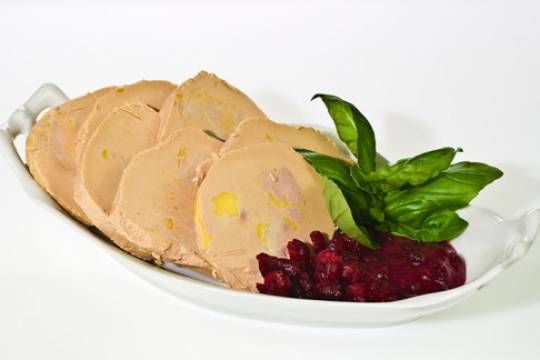
Pate is one of the most common types of canned food on our table, which, however, has recently been increasingly condemned by animal rights activists. Do birds get sick from overeating or is it a myth? Farmers will talk about this, and the TV program “NashPotrebNadzor” talked about how to choose a tasty and healthy goose pate.
The most famous pate is produced in the largest volume in France. Goose liver pate is considered the most expensive and delicious. In France it is called "foie gras". It is foie gras that is the ancestor of all types of pates familiar to us. And for a long time the French talked about its production with pride. Now everything has changed - journalists have repeatedly looked at the pate production process through the prism of animal husbandry, which has greatly alarmed the public. Farmers are afraid to allow media representatives near their farms and now, if they agree to give an interview, it is only on neutral territory, a shop where the finished product is sold or a restaurant where foie gras is served.
After public outcry began calling farmers flayers for overfeeding birds, causing them to become obese, the world's demand for goose liver products dropped significantly, causing many farms producing foie gras and pâtés to close.
The crux of the public outcry is that the birds are supposedly suffering because of their obesity. Why are birds fed this way? To understand the reasons for such treatment, it is necessary to know the pate production process. Foie gras literally means “fat liver” in French. On farms, geese and ducks are kept in cramped pens and fed twice a day. Here is the nuance - they are force-fed. So that the bird eats about 20% more than normal. To simplify this process, a tube is inserted into the bird's throat, through which the required amount of feed is poured directly into the esophagus. Along with the feed mixture, special round pebbles are thrown into the tube to help grind hard grains. On such a diet, the crack liver grows up to 500 g in three weeks, and in geese - up to 1,200 g. Foie gras from such a liver is valued by gourmets for its tenderness and aroma, while animal rights activists call this method of feeding the most violent manifestation of human cruelty. attitude towards animals.
Farmers note that liver enlargement does not cause discomfort to either geese or ducks, because These are migratory birds and their livers are naturally designed to store energy in the form of fat. But chicken is a non-migratory bird, and therefore its liver is dietary. For the same reason, no one makes pate only from chicken liver - it is watery and without adding meat, the result is not a pate, but liver slurry.
Foie gras or lard?
Coming to the program “OurPotrebNadzor”
I purchased four samples of goose liver pate from the brands
“Hame”, “Glavprodukt”, “Vkusvill”
and
“NFKZ”
. The Center for Hygiene and Epidemiology of Rospotrebnadzor checked these samples for safety and compliance with established standards.
First of all, the laboratory examined the samples for the presence of heavy metals, pesticides and pathogenic bacteria, but did not find anything posing a health hazard in any of the pates.
Next, experts checked the samples for preservative content. And, if in goose liver pates “Glavprodukt”, “Vkusvill”
and
"NKVZ"
they were not found, then sodium nitrite (E250) was found in the
"Hame"
, but in an amount not exceeding the permissible value.
Next, experts checked the actual nutritional value of the pates for compliance with the data indicated on the packaging. And, despite the fact that the amount of proteins and fats in all jars is different, there was no reason for comments here.
But the composition of the pates turned out to be completely different. You could guess this from the name of the product: goose liver pate contains more healthy goose liver and more vitamin A than, for example, goose liver pate or goose liver pate. But, despite the fact that only the “Vkusville”
, the rest also remain without comments, because do not pose a danger to life and health, and the composition is honestly indicated on the packaging.
Thus, all samples of the tested pate turned out to be safe and suitable for consumption, but only goose liver pate “Vkusville”
It’s really made from goose liver, which means it’s many times healthier than the pork-based pates
“Glavprodukt”, “Hame”
and
“NKVZ”
.
0
Author of the publication
offline 2 hours
Loginov Anton
85
Russia. Moscow city
41 years old
Birthday: October 09, 1978
Comments: 3 Publications: 16072 Registration: 09/10/2018
Bird for foie gras
Initially, foie gras included goose liver
. Now about 90% of all products are made from duck liver. This is due to the fact that the goose is a particularly demanding bird when it comes to personal care, and this in turn leads to an increase in the price of the product. For future food, ducklings of two breeds are raised:
- "
Barbari "
is a musky duck, a large species of animal. The weight of an adult drake reaches 5 - 6 kilograms, which exceeds the weight of most breeds. The main feature of “barbari” is considered to be excellent resistance to diseases and infections. - “
Mulard ” -
the lack of record weight is compensated by its unpretentiousness in its maintenance, stability in weight gain and adaptation to local food. The liver of this particular hybrid breed is ideal for preparing foie gras.
During the first month of their life, ducklings develop naturally, after which they begin to receive an unlimited amount of food. 600-700 grams within 20 days
.
How to cook foie gras
Not only an experienced chef, but also any housewife can prepare this gastronomic masterpiece. There are a huge number of recipes. Let's focus on two of them.
Classic foie gras tablet
.
- Goose or duck liver - 650 g;
- Pork fillet - 350 g;
- Lard - 350 g;
- Salt - 1 tablespoon;
- Milk;
- Cognac - 40 g;
- Truffle or porcini mushroom;
- Spices: bay leaf and pepper.
Quite affordable products, with the exception of the expensive truffle, which can be replaced with porcini mushroom
.
Cooking process:
- It is soaked in milk and then stuffed with small pieces of mushroom, about 450 grams of liver. Before putting the workpiece to marinate, the product is poured generously with cognac.
- The meat fillet and the remaining goose liver are passed through a meat grinder three times. To make the resulting mass as soft and tender as possible, you need to use a fine lattice. Cognac, which was used for marinating, is mixed into the minced meat, salt and pepper are added.
- The walls and bottom of the round shape should be covered with a small layer of the resulting minced meat. Small pieces of liver are placed inside, which are covered with the remaining minced meat. The top is covered with pieces of lard and bay leaves.
- Place the mold in a water bath in the oven for half an hour. After cooking is complete, the bay leaf and lard are removed, leaving the dish itself in a delicious shell of fat.
- Minced foie gras is served chilled.
Fried foie gras.
This recipe is considered one of the most common. For preparation you will need:
- Duck liver - 450 g;
- Pepper, salt, green salad leaves.
Cooking process:
- Cut the liver into two parts and place in the refrigerator for 30 - 40 minutes.
- Salt and pepper the cooled product and place it in a heated frying pan.
- Fry each side for 2 minutes, then place in the oven in a water bath for 20 minutes.
- Decorate the finished dish with green salad leaves.
When frying, do not add oil to the pan. When cooked, the liver releases a huge amount of its own fat, which is used to cook. While cooking in the oven, you need to baste the foie gras with its own fat every 5 minutes.
Useful properties of the product
The presence of vitamins and amino acids in goose liver is not the main reason for the popularity of this delicacy. But, nevertheless, foie gras lovers will be interested to know
What:
- People who consume this dish daily do not suffer from atherosclerosis;
- The presence of a large amount of polyunsaturated fatty acids lowers cholesterol levels;
- The Landes department (where foie gras production accounts for 22% of the world's total) has a large percentage of centenarians;
- Duck liver is a record holder for the amount of B vitamins that improve metabolism and normalize the functioning of the nervous system.
A properly prepared dish can provide the adult body with the daily requirement of most vitamins and minerals.
Opponents of the dish
A person who has tried foie gras for the first time will be very surprised when he learns about the number of animal protection organizations demanding that this dish be banned. The reason lies in the inhumane attitude towards poultry raising, namely force-feeding. In some countries and in some states of America, the production of poultry for this delicacy is prohibited by law.
Supporters claim that no violent actions are carried out against the geese, and after stopping the “ gavage”
“(this is what force feeding is called) all the organs of the bird return to normal size, without subsequently causing pain and discomfort to the animal.
You have discovered the most favorite delicacy of millions of gourmets from all over the world - foie gras. People learned what it was about 4,000 years ago, and now this dish has become one of the most popular delicacies of our time. This delicious dish, traditional for Western Europe, the USA and Japan, has found fans in our country. We hope that these recipes will help you decorate your holiday table and surprise your family and friends with an unusual dish.

